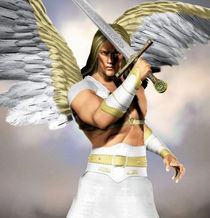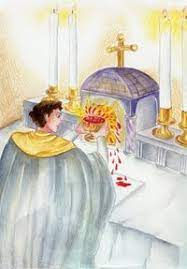The Guardian Angel: Eucharistic Miracle of Legnica, Poland, 2013
- Donald Hartley

- Jun 14, 2021
- 6 min read
Updated: Jun 15, 2021

In St. Hyacinth’s church in Legnica, during Holy Mass, on December 25, 2013, a Host accidentally fell on the ground, during the distribution of Communion. It was immediately placed in a container with water and closed in the tabernacle as required by code of Canon Law.
A few days later, a red spot appeared on Its surface. The Bishop of Legnica at the time, Stefan Cichy, decided to establish a commission for a scientific analysis. The results were surprising, and confirmed that It had similarities to “human heart muscle with alterations that often appear during the agony”.
In St. Hyacinth’s church in Legnica, during Holy Mass, on December 25, 2013, a Host accidentally fell on the ground, during the distribution of Communion. It was immediately placed in a container with water and closed in the tabernacle.

St. Hyacinth’s priest, Father Andrzej Ziombra, said that on January 4th, along with other priests, he went to see if the consecrated Host had dissolved in the water after nearly two weeks: "Immediately we noticed that the Host had not dissolved, and that a red spot covering a fifth of Its surface appeared. We decided to inform the Bishop, who established a special theological scientific commission to analyze the event.
We noticed that over time the stain on the Host changed color from deep red to red brown (...). The sample was taken directly by the scientists on 26 January 2014.
For the priests the miracle was evident. The commission checked if It was some fungus, mold or another external agent (...). The Wrocław Forensic Medicine Institute immediately excluded the presence of bacteria or fungi as a cause for the Host turning red.

A second histopathological analysis pointed out that some fragments seemed to belong to myocardial tissue. An additional opinion was sought using the same samples at the Institute of Forensic Medicine in Szczecin without specifying where the samples came from. The Institute used a different analysis method.
After the analysis, The Pomeranian Medical University’s Department of Histopathology in Szczecin announced that “tissue fragments containing fragmented parts of cross-striated muscle” was found in the histopathological image. This is similar to “human heart muscle with alterations that often appear during the agony. We have not tested the blood found on the Host, we only know that human DNA was found.”

The results of the analysis were presented to the Vatican’s Congregation for the Doctrine of the Faith, which recognised the supernatural nature of the event. It is striking that the examination results were similar to those of the Lanciano Eucharistic Miracle of 700 A.D. and other Miracles that occurred recently such as Sokolka in 2008, in Poland, Tixtla in 2006 in Mexico, and Buenos Aires, in Argentina in 1996.
On April 17, 2016, following the instructions received by the Holy See, Monsignor Zbigniew Kiernikowskiego, the new Bishop of Legnica, announced during Mass that the parish priest Fr Andrzej Ziombra should "prepare a suitable place for the exhibition of the precious relic, so that the faithful can express their adoration properly".

Father Hardon is one of my heroes, listen to him as he speaks on the Holy Eucharist and the Sacred Heart of Jesus. Then share with those you love, the most recent Eucharistic Miracle approved THIS YEAR!!! Love and mercy to each of you, GregoryMary
The Sacred Heart is the Holy Eucharist
Why do we make this equation? What do we mean when we say the Sacred Heart is the Holy Eucharist? We begin by recalling the centuries of Church teaching on what the term “Sacred Heart” expresses. The Sacred Heart signifies Christ’s love in three ways: God is love, God is loving and God loves with human feeling.

God is love. The Sacred Heart symbolizes the love that is God. From all eternity, God is love. That is the primary meaning of God as a Divine Community and not a single person. The essence of love is to give, and within the Trinity, each of the three Divine Persons from all eternity shares the divine nature that each one possesses. When we say God is love, we are defining God as that Community of three Divine Persons who, from all eternity, each share with the other the fullness of what each one not only has, but of what each one is.
God is loving. God is loving not only by bringing us into being, but by bringing us into being as creatures who are capable of love. God could of made us insects or animals or trees or lofty mountains, but these cannot think and love. When this loving God chose to create other beings, it was only because He is loving that He wanted to share what He as God had from all eternity (love) with beings who would not even exist without His love. From the moment of creation and into the endless reaches of eternity, God will continue loving us. If He were to cease loving us, we would cease to exist!

God manifested His love by bringing us into existence and making us creatures who are capable of love.
But God also manifested His by becoming one of us, and, having become one of us, He has remained and will be for all eternity one of us. When the Word became Flesh, It became Flesh not only for a time, but for all eternity. God will remain Incarnate forever.
This loving God, who out of love for us became man and died on the Cross to show His love for us, this God became man and remains man, but He remains man on earth.
It is no exaggeration to say that the Sacred Heart is the Holy Eucharist. The Eucharist is the same Infinite Love who is God and who out of love for us became man and is here on earth. When we receive Him, that same God is within us. Love wants us to be intimate. Love wants us to be near. Love wants us to be close to the one whom it loves. The Holy Eucharist is divine genius!

God loves with human feeling. The third meaning which the Church gives to the Sacred Heart as symbolizing God’s love is that God loves not only as God but also as the God-man with human feeling, human emotion, human sensibility and human sensitivity. We creatures of feeling, emotion and sensitivity need to hear this. God in the Holy Eucharist is man indeed, but with all the supreme sensitivity. Christ in the Blessed Sacrament is a sensitive Christ. He feels.St. Margaret Mary tells us that Christ in the Eucharist senses in a way we as hypersensitive human beings can understand.
Wives tell me, “I spend hours cooking the meal and all my husband does is sit down, eat and even ask for more. But he never thanks me!” Or among religious, “Father, you have no idea how much it hurts me to know that when we pass in the corridor, he does not even look at me.” How sensitive we are! How we need to know that God became a sensitive human being! When we come to Him in the Blessed Sacrament, He wants us to tell Him how we feel, and He will tell us how He feels. When we come to Church, we should not leave our heart in the car. When Christ came to earth, He did not leave His Heart in heaven.
The Blessed Virgin and The Holy Eucharist by Fr. John A Hardon, S.J.
There is no secret about how the Blessed Virgin is related to the Holy Eucharist. It is very simple: except for the Blessed Virgin, we would not have the Holy Eucharist.
The key to this relationship is the humanity of Jesus Christ. God as God, was present in the world from the dawn of creation. The same almighty power by which God brought the world into being is the same almighty power by which He sustains the world in existence and provides for its constant activity.

But something historic happened at the Annunciation. The moment Mary told the angel, "Be it done to me according to Your word," God began to be present in the world as man. The infant in Mary's womb was her God become Incarnate. It was the Word made Flesh. It was the Lord of the Universe become a human child.
It was from Mary that the Son of God took our human nature. It was from Mary that the Second Person of the Trinity received His humanity. It was through Mary that Jesus Christ, who is God from all eternity, became man, lived visibly on earth in Palestine and is now invisibly on earth in every church and chapel in the Catholic world where the Holy Eucharist is offered, received and reserved.
Mary's relationship to her Son has not changed since the Annunciation. As His Mother, she remains the Mother of Divine Grace, through whom He pours out His blessings on a sinful world. As Pope John Paul II observed in Redemptoris Mater, "Mary guides the faithful to the Eucharist."





















Comments